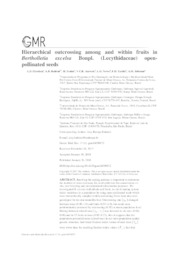Hierarchical outcrossing among and within fruits in Bertholletia excelsa Bonpl. (Lecythidaceae) open-pollinated seeds.
Hierarchical outcrossing among and within fruits in Bertholletia excelsa Bonpl. (Lecythidaceae) open-pollinated seeds.
Author(s): BALDONI, A. B.; TONINI, H.; AZEVEDO, V. C. R.; TARDIN, F. D.
Summary: Knowing the mating patterns is important to determine the number of trees necessary for seed collection for conservation ex situ, tree breeding and environmental reforestation purposes. We investigated B. excelsa individuals and fruits, to check mating system index variations in a population by using open-pollinated seeds which were hierarchically sampled within and among fruits from nine trees genotyped for ten microsatellite loci. Outcrossing rate ( tm ) changed between trees (0.49?1.0) and fruits (0.53?1.0), but seeds were predominantly produced by outcrossing (0.92) at mean population level. Mating between related trees ( tm ts ) was detected in six trees (0.04?0.08) and in 32 fruits in trees (0.03?0.22), thus it suggests that the population presented some related trees in our intra-population spatial genetic structure. Individual fixation index values of seed trees ( Fm ) were lower than the seedling fixation index values ( o F ), fact that suggests the selection against inbred individuals between the seed and adult stages. The correlated mating showed that seeds sampled at population level were predominantly composed of half-sibs (66%) and full-sibs (20%). Paternity correlation was significantly higher within (p(w) r ) than among ( p(a) r ) fruits at population level, mostly in individual trees. Results evidenced that mating was not random due to self-fertilization, to mating between related trees and correlated mating, and families comprised different relatedness levels such as half-sibs, full-sibs, self-sibs and self-half-sibs; some cases, mating presented inbreeding. These results were addressed to discuss strategies for seed collection applied to conservation ex situ, tree breeding and environmental reforestation.
Publication year: 2018
Types of publication: Journal article
Observation
Some of Embrapa's publications are published as ePub files. To read them, use or download one of the following free software options to your computer or mobile device. Android: Google Play Books; IOS: iBooks; Windows and Linux: Calibre.
Access other publications
Access the Agricultural Research Database (BDPA) to consult Embrapa's full library collection and records.
Visit Embrapa Bookstore to purchase books and other publications sold by Embrapa.

